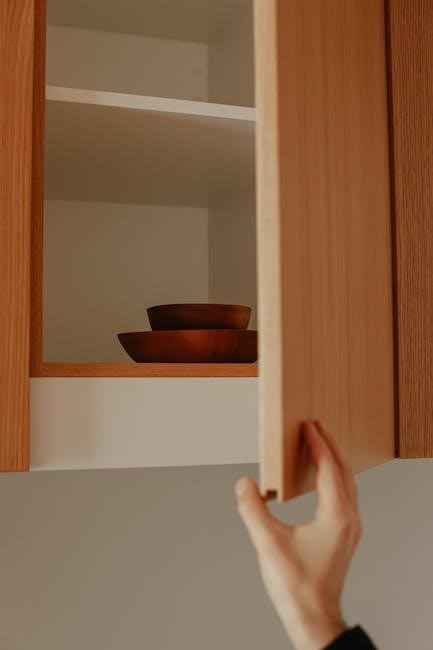Honeywell RTH7560E1001 Manual: A Comprehensive Guide
Welcome! This comprehensive guide provides detailed information for the Honeywell RTH7560E1001 thermostat. Whether you’re a new user or looking to troubleshoot, this resource will assist you in understanding and utilizing your thermostat effectively.
The Honeywell RTH7560E1001 is a popular 7-day programmable thermostat designed for ease of use and energy savings. This thermostat allows you to create custom heating and cooling schedules that fit your lifestyle, optimizing comfort while minimizing energy consumption. Understanding its features is crucial for effective use.
This model offers flexibility with weekday and weekend programming, or individual day settings. It adapts to your needs, offering up to four adjustment points daily. Smart Response Technology learns your heating/cooling patterns, ensuring optimal temperature when you want it. The RTH7560E1001 simplifies home climate control.
This thermostat is suitable for various systems, including gas, oil, electric, and heat pump configurations. Its user-friendly interface and clear display make programming straightforward. Whether you’re looking to save money on energy bills or maintain a comfortable home environment, the Honeywell RTH7560E1001 provides a reliable and efficient solution for your home’s temperature control needs.
Where to Find the Honeywell RTH7560E1001 Manual
Accessing the Honeywell RTH7560E1001 manual is simple and can be done through several convenient methods. The primary source is the Honeywell Home website, where you can search for the specific model number to download the manual in PDF format. This ensures you have the most accurate and up-to-date information.
Many third-party websites, like Manuals.ca and ThermostatManuals.com, also host the RTH7560E1001 manual for free viewing or download. These sites often provide user forums where you can ask questions and get advice from other owners.
Additionally, check the packaging that came with your thermostat, as it may include a printed quick installation guide or a link to the full manual online. If you’ve misplaced the physical copy, the digital versions are readily available and easily accessible on your computer, tablet, or smartphone, ensuring you always have the information you need at your fingertips.

Key Features and Functions
The Honeywell RTH7560E1001 thermostat boasts a 7-day programmable schedule, multiple system modes (Auto, Heat, Cool, Off), and adjustable fan settings (Auto, On). Its Smart Response Technology learns heating/cooling cycles for optimal comfort.
Understanding the 7-Day Programmable Schedule
The Honeywell RTH7560E1001 thermostat’s 7-day programmable schedule provides exceptional flexibility in managing your home’s temperature. This feature allows you to customize heating and cooling settings for each day of the week, tailoring them to your unique lifestyle and occupancy patterns.
Instead of a generic, one-size-fits-all approach, you can set different temperatures for different times of the day. For example, you might want to lower the heat while you’re at work and increase it before you return home. Weekends can have entirely different settings to reflect your relaxed schedule.

Many users appreciate that the RTH7560E1001 allows setting four different periods each day. These periods are typically Morning, Day, Evening, and Night, offering very granular control. With this feature, energy consumption can be optimized to reduce heating and cooling costs, ensuring comfort only when it is needed.
System Modes: Auto, Heat, Cool, and Off
The Honeywell RTH7560E1001 thermostat offers four primary system modes, each designed to address different climate control needs. Understanding these modes is crucial for optimal performance and energy efficiency.
Auto mode allows the thermostat to automatically switch between heating and cooling as needed to maintain the set temperature. This is ideal for climates with fluctuating temperatures.
Heat mode engages only the heating system, maintaining the desired warmth during colder months. Similarly, Cool mode activates only the air conditioning, providing relief in hot weather.
Finally, Off mode completely disables both heating and cooling systems. This is useful when the home is unoccupied or during moderate weather when climate control isn’t necessary. Properly utilizing these modes ensures comfort while optimizing energy usage, and can be easily selected from the home screen.
Fan Operation: Auto and On Settings

The Honeywell RTH7560E1001 thermostat provides two distinct fan operation settings: Auto and On. These settings control how the fan in your HVAC system operates, impacting both comfort and energy consumption.
In Auto mode, the fan runs only when the heating or cooling system is active. This is the most energy-efficient setting, as the fan isn’t constantly running and consuming power. It’s suitable for most situations where consistent airflow isn’t a primary concern.
Conversely, the On setting keeps the fan running continuously, regardless of whether the heating or cooling system is in operation. This provides constant air circulation, which can help to even out temperature distribution throughout your home and improve air quality.
However, the On setting consumes more energy than the Auto setting. The selection depends on individual comfort and energy-saving priorities.
Smart Response Technology
The Honeywell RTH7560E1001 thermostat incorporates Smart Response Technology, a feature designed to optimize your home’s heating and cooling performance. This technology enables the thermostat to “learn” how long it takes for your system to reach the desired temperature.
Instead of simply turning on the system at the scheduled time, Smart Response Technology anticipates the required lead time. It activates the heating or cooling system earlier, ensuring your home reaches the set temperature precisely when you want it to.
This intelligent adaptation prevents temperature fluctuations and enhances overall comfort. By minimizing temperature swings, Smart Response Technology also contributes to energy savings. The system operates more efficiently because it’s not overshooting or undershooting the target temperature.
The result is a more comfortable and energy-efficient home environment, as the thermostat adapts to your home’s unique heating and cooling characteristics.

Setting Up and Programming
This section guides you through setting up and programming your Honeywell RTH7560E1001 thermostat; Learn to configure initial settings, create custom schedules, and manually override programs for optimal comfort.
Initial Setup: Date, Time, and System Type

Before fully utilizing the Honeywell RTH7560E1001 thermostat’s programmable features, the initial setup is crucial. Setting the correct date and time ensures accurate scheduling and operation. To begin, navigate to the setup menu, typically accessible through the “Menu” button on the thermostat. Use the arrow keys to adjust the month, day, and year, confirming each selection with the “Done” or “Next” button.
Next, configure the time. Select the hour and minute, ensuring you choose AM or PM correctly. Accurate timekeeping is essential for the thermostat to follow your programmed schedule effectively. Finally, specify your system type. This setting tells the thermostat whether you have a conventional heating and cooling system or a heat pump. Select the appropriate option based on your home’s HVAC setup. This selection is critical for proper thermostat operation and energy efficiency. Confirm all settings to complete the initial setup.
Creating a Custom Schedule
The Honeywell RTH7560E1001 thermostat excels in its ability to create custom heating and cooling schedules, perfectly tailored to your lifestyle. To begin programming, access the scheduling menu, often labeled “Program” or “Schedule”. The thermostat offers flexible scheduling options, allowing you to program each day individually or group weekdays and weekends.
For each day or group of days, you can set up to four different periods: Wake, Leave, Return, and Sleep. For each period, define the desired temperature for both heating and cooling. Consider your typical activities during these times – setting lower temperatures when you’re away and comfortable temperatures when you’re home. Use the arrow keys to adjust the temperature for each period and the “Next” button to move to the next setting. Once you’ve programmed all periods for each day, review your schedule to ensure it aligns with your preferences. Save your settings to activate the custom schedule, optimizing comfort and energy savings.
Overriding the Program Schedule Manually
Sometimes, you might need to deviate from your pre-programmed schedule. The Honeywell RTH7560E1001 allows for easy manual overrides. To temporarily adjust the temperature, simply use the up and down arrow buttons on the thermostat’s face. This will override the current programmed setting until the next scheduled period begins.
If you want to hold a specific temperature for an extended period, you can activate the “Hold” feature. After setting the desired temperature with the arrow buttons, press the “Hold” button. The thermostat will maintain this temperature indefinitely, bypassing the programmed schedule. To release the “Hold” and return to the programmed schedule, simply press the “Run” or “Cancel Hold” button. This manual override functionality provides flexibility and control, ensuring comfort even when your routine changes unexpectedly. It’s a convenient way to adapt to varying weather conditions or personal preferences without permanently altering your programmed schedule.

Troubleshooting and FAQs
This section addresses common issues encountered with the Honeywell RTH7560E1001. Find solutions to problems like unresponsive thermostats, incorrect readings, programming difficulties, and instructions for resetting to factory settings.

Thermostat Not Responding
If your Honeywell RTH7560E1001 thermostat isn’t responding, several factors could be the cause. First, ensure the thermostat display is lit. If it’s blank, check the batteries and replace them if necessary, ensuring correct polarity. A low battery can prevent the thermostat from functioning correctly.
Next, verify the circuit breaker connected to your HVAC system hasn’t tripped. Resetting the breaker might restore power to the system and the thermostat. Also, confirm the system switch is set to “Heat,” “Cool,” or “Auto,” depending on your desired operation mode. Ensure that the fan switch is properly set as well.
If the issue persists, try a soft reset by removing the thermostat from its wall plate for a few minutes, then reattaching it. This can sometimes resolve minor software glitches. If none of these steps work, consult the complete manual or contact Honeywell support for further assistance.
Incorrect Temperature Readings
Experiencing inaccurate temperature readings with your Honeywell RTH7560E1001 thermostat? Several factors can contribute to this issue. Firstly, ensure the thermostat is mounted on an interior wall, away from direct sunlight, drafts, or heat sources like lamps or appliances. These external factors can significantly influence the thermostat’s readings.
Secondly, check for any obstructions around the thermostat that might impede airflow, such as furniture or curtains. Proper airflow is crucial for accurate temperature sensing. Also, verify the thermostat is securely mounted on the wall plate and that all wiring connections are secure.
If the problem continues, consider calibrating the thermostat’s temperature sensor. Some models allow you to adjust the displayed temperature to match a separate, reliable thermometer. Refer to your user manual for specific instructions on temperature calibration. If calibration doesn’t resolve the issue, consult Honeywell support for further troubleshooting steps.
Programming Issues
Encountering difficulties programming your Honeywell RTH7560E1001 thermostat? Start by confirming that the thermostat is set to the correct system mode (Heat, Cool, or Auto). Incorrect mode selection can prevent the programmed schedule from functioning as expected. Next, carefully review the programmed schedule to ensure the correct times and temperatures are set for each day and period.
Pay close attention to the “hold” or “override” settings, as these can temporarily suspend the programmed schedule. If the thermostat is in “hold” mode, it will maintain a constant temperature until the hold is released. Also, check the battery level. Low batteries can sometimes cause programming glitches or memory loss.
If problems persist, try resetting the thermostat to its factory default settings. This will erase all programmed settings, allowing you to start fresh. Consult the user manual for instructions on performing a factory reset. If resetting doesn’t resolve the issue, contact Honeywell support for further assistance.
Resetting to Factory Settings
Resetting your Honeywell RTH7560E1001 thermostat to factory settings can resolve various issues, such as programming errors or unexpected behavior. Before initiating a reset, note that this process will erase all custom settings, including your programmed schedule, date, and time. Consult your user manual for specific instructions, as the method may vary slightly depending on the model.
Generally, resetting involves pressing and holding a specific combination of buttons for a set duration. For example, you might need to simultaneously press the “System,” “Fan,” and “Hold” buttons until the display indicates a reset. Once the reset is complete, the thermostat will revert to its original factory configuration.
After the reset, you’ll need to reconfigure the initial settings, such as date, time, and system type (Heat/Cool or Heat Pump). You will also need to reprogram your desired heating and cooling schedule. This ensures that the thermostat operates according to your preferences and energy-saving goals. If you are still experiencing issues after the reset, consider contacting Honeywell support.

Installation Guide
This section provides a basic overview. Always consult the official Honeywell RTH7560E1001 manual for detailed safety instructions and step-by-step guidance before installing your new thermostat to ensure proper installation.
Removing the Old Thermostat
Before commencing the removal of your old thermostat, it is paramount to switch off the power supply to your heating and cooling system at the breaker. This crucial safety step mitigates the risk of electrical shock during the process. Carefully detach the thermostat cover, which may be secured by screws or clips.
Next, scrutinize the wiring configuration. Take detailed notes or a photograph of the existing wiring connections. Label each wire with tape indicating its corresponding terminal. This documentation will prove invaluable when connecting the wires to your new Honeywell RTH7560E1001 thermostat.
Once the wiring is documented, carefully disconnect each wire from the old thermostat. Use a screwdriver to loosen the terminal screws or press the release tabs. After all wires are detached, unscrew the mounting plate from the wall. Gently remove any remaining adhesive or residue. Finally, you’re ready to install the new thermostat.
Wiring Instructions for Different Systems
Proper wiring is crucial for optimal performance. First, identify your system type: conventional (gas, oil, or electric) or heat pump. For conventional systems, typically connect the R wire to Rh or Rc (use a jumper if needed), the W wire to the heating terminal, Y to cooling, and G to the fan. If you have both Rh and Rc terminals, remove the jumper wire.
Heat pump systems require a different configuration. The O/B wire connects to the appropriate terminal for reversing valve operation (check your old thermostat’s wiring). The remaining wires connect similarly: R to Rh, Y to cooling, G to fan, and W/Aux to auxiliary heat.
Always consult the Honeywell RTH7560E1001 manual for specific wiring diagrams tailored to your system. Ensure all connections are secure. Incorrect wiring can damage your thermostat or HVAC equipment. If unsure, consult a qualified HVAC technician to avoid potential problems. Verify all connections before powering on.
Mounting the New Thermostat
Once the wiring is complete, carefully proceed with mounting the Honeywell RTH7560E1001 thermostat. Gently push the excess wires back into the wall opening. Align the thermostat base plate with the wall mounting holes, ensuring it’s level for accurate temperature readings. Use the provided screws to securely attach the base plate to the wall.
Next, align the thermostat body with the base plate and gently snap it into place. Ensure it’s firmly attached. Install batteries. After installation, power on your HVAC system and test the thermostat’s functionality. Verify that both heating and cooling modes are working correctly.
If issues arise, double-check the wiring connections and consult the troubleshooting section of the Honeywell RTH7560E1001 manual. Proper mounting ensures accurate temperature sensing and reliable operation. A level installation prevents skewed readings, leading to improved energy efficiency.

Additional Resources
For further assistance and information, explore Honeywell’s official website. You’ll find support documents, FAQs, and contact information. Additionally, research related Honeywell thermostat models for comparison and alternative options.
Honeywell Support Website
The official Honeywell support website is your primary hub for all things related to your RTH7560E1001 thermostat. Navigating this resource effectively can resolve common queries and issues. You’ll discover downloadable manuals, which offer detailed instructions and troubleshooting steps.
Explore the frequently asked questions (FAQs) section, addressing common concerns from users like you. This section covers topics ranging from basic programming to advanced system settings. Honeywell’s website typically includes video tutorials, demonstrating key functionalities and setup procedures.
If you require personalized assistance, the website provides contact information for customer support. Reach out via phone, email, or live chat, depending on availability. The support team can guide you through complex issues or provide clarifications on specific features.
Regularly check the website for updates and firmware enhancements, ensuring optimal thermostat performance. The Honeywell support website is a valuable tool for maximizing your thermostat’s capabilities and longevity.
Related Honeywell Thermostat Models
Honeywell offers a wide range of thermostats, each with unique features. Exploring related models can provide insights and alternative options. The RTH7500 series shares similar programming capabilities, offering a familiar user experience. Consider the RTH7600 for advanced features like touchscreen control and enhanced scheduling.
The T5 and T6 series thermostats offer smart home integration, allowing remote control via mobile apps. These models often include geofencing capabilities, adjusting temperatures based on your location. The older RTH5160 series provides a simpler, non-programmable option for basic temperature control.
When researching, compare features like display type, programming flexibility, and smart home compatibility. Check user reviews to understand real-world performance and reliability. Consider your specific needs and budget to determine the best Honeywell thermostat for your home. Exploring these alternatives can help you appreciate the RTH7560E1001’s features or identify a more suitable option. Always consult product manuals before purchasing.



Leave a Reply
You must be logged in to post a comment.